Chapter 4.3: The Derivative as a Function
Learning Objectives
- Define the derivative function of a given function.
- Graph a derivative function from the graph of a given function.
- State the connection between derivatives and continuity.
- Describe three conditions for when a function does not have a derivative.
- Explain the meaning of a higher-order derivative.
As we have seen, the derivative of a function at a given point gives us the rate of change or slope of the tangent line to the function at that point. If we differentiate a position function at a given time, we obtain the velocity at that time. It seems reasonable to conclude that knowing the derivative of the function at every point would produce valuable information about the behavior of the function. However, the process of finding the derivative at even a handful of values using the techniques of the preceding section would quickly become quite tedious. In this section we define the derivative function and learn a process for finding it.
Derivative Functions
The derivative function gives the derivative of a function at each point in the domain of the original function for which the derivative is defined. We can formally define a derivative function as follows.
Definition
Let ![]() be a function. The derivative function, denoted by
be a function. The derivative function, denoted by ![]() , is the function whose domain consists of those values of
, is the function whose domain consists of those values of ![]() such that the following limit exists:
such that the following limit exists:
A function ![]() is said to be differentiable at
is said to be differentiable at ![]() if
if
![]() exists. More generally, a function is said to be differentiable on
exists. More generally, a function is said to be differentiable on ![]() if it is differentiable at every point in an open set
if it is differentiable at every point in an open set ![]() , and a differentiable function is one in which
, and a differentiable function is one in which ![]() exists on its domain.
exists on its domain.
In the next few examples we use (Figure) to find the derivative of a function.
Finding the Derivative of a Square-Root Function
Find the derivative of ![]() .
.
Finding the Derivative of a Quadratic Function
Find the derivative of the function ![]() .
.
Solution
Follow the same procedure here, but without having to multiply by the conjugate.

Find the derivative of ![]() .
.
Solution
![]()
We use a variety of different notations to express the derivative of a function. In (Figure) we showed that if ![]() , then
, then ![]() . If we had expressed this function in the form
. If we had expressed this function in the form ![]() , we could have expressed the derivative as
, we could have expressed the derivative as ![]() or
or ![]() . We could have conveyed the same information by writing
. We could have conveyed the same information by writing ![]() . Thus, for the function
. Thus, for the function ![]() , each of the following notations represents the derivative of
, each of the following notations represents the derivative of ![]() :
:
In place of ![]() we may also use
we may also use ![]() Use of the
Use of the ![]() notation (called Leibniz notation) is quite common in engineering and physics. To understand this notation better, recall that the derivative of a function at a point is the limit of the slopes of secant lines as the secant lines approach the tangent line. The slopes of these secant lines are often expressed in the form
notation (called Leibniz notation) is quite common in engineering and physics. To understand this notation better, recall that the derivative of a function at a point is the limit of the slopes of secant lines as the secant lines approach the tangent line. The slopes of these secant lines are often expressed in the form ![]() where
where ![]() is the difference in the
is the difference in the ![]() values corresponding to the difference in the
values corresponding to the difference in the ![]() values, which are expressed as
values, which are expressed as ![]() ((Figure)). Thus the derivative, which can be thought of as the instantaneous rate of change of
((Figure)). Thus the derivative, which can be thought of as the instantaneous rate of change of ![]() with respect to
with respect to ![]() , is expressed as
, is expressed as
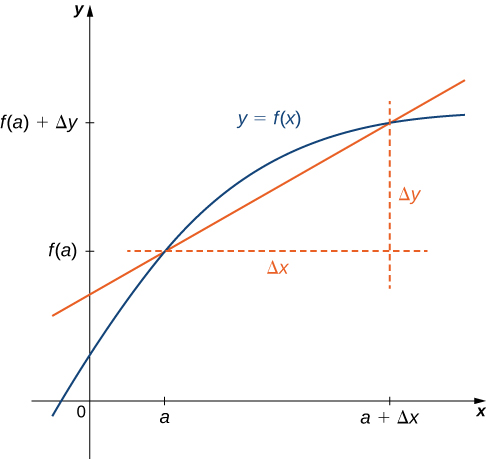
 .
.Graphing a Derivative
We have already discussed how to graph a function, so given the equation of a function or the equation of a derivative function, we could graph it. Given both, we would expect to see a correspondence between the graphs of these two functions, since ![]() gives the rate of change of a function
gives the rate of change of a function ![]() (or slope of the tangent line to
(or slope of the tangent line to ![]() ).
).
In (Figure) we found that for ![]() . If we graph these functions on the same axes, as in (Figure), we can use the graphs to understand the relationship between these two functions. First, we notice that
. If we graph these functions on the same axes, as in (Figure), we can use the graphs to understand the relationship between these two functions. First, we notice that ![]() is increasing over its entire domain, which means that the slopes of its tangent lines at all points are positive. Consequently, we expect
is increasing over its entire domain, which means that the slopes of its tangent lines at all points are positive. Consequently, we expect ![]() for all values of
for all values of ![]() in its domain. Furthermore, as
in its domain. Furthermore, as ![]() increases, the slopes of the tangent lines to
increases, the slopes of the tangent lines to ![]() are decreasing and we expect to see a corresponding decrease in
are decreasing and we expect to see a corresponding decrease in ![]() . We also observe that
. We also observe that ![]() is undefined and that
is undefined and that ![]() , corresponding to a vertical tangent to
, corresponding to a vertical tangent to ![]() at 0.
at 0.
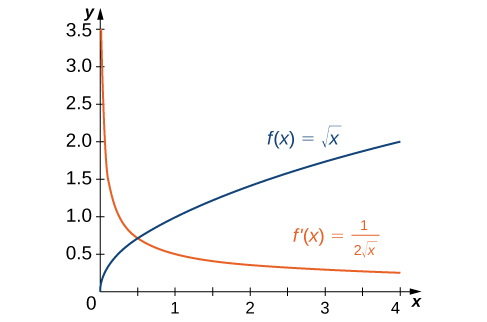
 is positive everywhere because the function
is positive everywhere because the function  is increasing.
is increasing.In (Figure) we found that for ![]() . The graphs of these functions are shown in (Figure). Observe that
. The graphs of these functions are shown in (Figure). Observe that ![]() is decreasing for
is decreasing for ![]() . For these same values of
. For these same values of ![]() . For values of
. For values of ![]() is increasing and
is increasing and ![]() . Also,
. Also, ![]() has a horizontal tangent at
has a horizontal tangent at ![]() and
and ![]() .
.
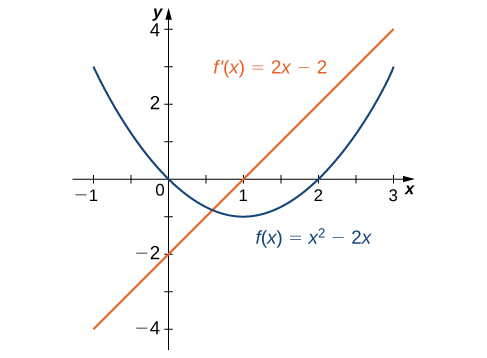
 where the function
where the function  is decreasing and
is decreasing and  where
where  is increasing. The derivative is zero where the function has a horizontal tangent.
is increasing. The derivative is zero where the function has a horizontal tangent.Sketching a Derivative Using a Function
Use the following graph of ![]() to sketch a graph of
to sketch a graph of ![]() .
.
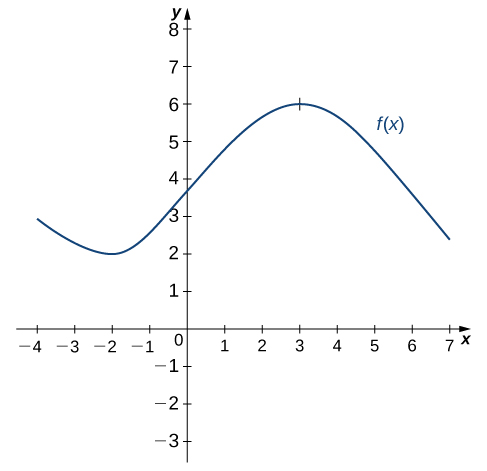
Solution
The solution is shown in the following graph. Observe that ![]() is increasing and
is increasing and ![]() on
on ![]() . Also,
. Also, ![]() is decreasing and
is decreasing and ![]() on
on ![]() and on
and on ![]() . Also note that
. Also note that ![]() has horizontal tangents at -2 and 3, and
has horizontal tangents at -2 and 3, and ![]() and
and ![]() .
.

Sketch the graph of ![]() . On what interval is the graph of
. On what interval is the graph of ![]() above the
above the ![]() -axis?
-axis?
Solution
![]()
Hint
The graph of ![]() is positive where
is positive where ![]() is increasing.
is increasing.
Derivatives and Continuity
Now that we can graph a derivative, let’s examine the behavior of the graphs. First, we consider the relationship between differentiability and continuity. We will see that if a function is differentiable at a point, it must be continuous there; however, a function that is continuous at a point need not be differentiable at that point. In fact, a function may be continuous at a point and fail to be differentiable at the point for one of several reasons.
Differentiability Implies Continuity
Let ![]() be a function and
be a function and ![]() be in its domain. If
be in its domain. If ![]() is differentiable at
is differentiable at ![]() , then
, then ![]() is continuous at
is continuous at ![]() .
.
Proof
If ![]() is differentiable at
is differentiable at ![]() , then
, then ![]() exists and
exists and
We want to show that ![]() is continuous at
is continuous at ![]() by showing that
by showing that ![]() . Thus,
. Thus,

Therefore, since ![]() is defined and
is defined and ![]() , we conclude that
, we conclude that ![]() is continuous at
is continuous at ![]() .
. ![]()
We have just proven that differentiability implies continuity, but now we consider whether continuity implies differentiability. To determine an answer to this question, we examine the function ![]() . This function is continuous everywhere; however,
. This function is continuous everywhere; however, ![]() is undefined. This observation leads us to believe that continuity does not imply differentiability. Let’s explore further. For
is undefined. This observation leads us to believe that continuity does not imply differentiability. Let’s explore further. For ![]() ,
,
This limit does not exist because
See (Figure).

 is continuous at 0 but is not differentiable at 0.
is continuous at 0 but is not differentiable at 0.Let’s consider some additional situations in which a continuous function fails to be differentiable. Consider the function ![]() :
:
Thus ![]() does not exist. A quick look at the graph of
does not exist. A quick look at the graph of ![]() clarifies the situation. The function has a vertical tangent line at 0 ((Figure)).
clarifies the situation. The function has a vertical tangent line at 0 ((Figure)).

![Rendered by QuickLaTeX.com f(x)=\sqrt[3]{x}](https://ecampusontario.pressbooks.pub/app/uploads/quicklatex/quicklatex.com-c3c5e7be9bc257eb2866277bae5be644_l3.png) has a vertical tangent at
has a vertical tangent at  . It is continuous at 0 but is not differentiable at 0.
. It is continuous at 0 but is not differentiable at 0.The function  also has a derivative that exhibits interesting behavior at 0. We see that
also has a derivative that exhibits interesting behavior at 0. We see that
This limit does not exist, essentially because the slopes of the secant lines continuously change direction as they approach zero ((Figure)).

 is not differentiable at 0.
is not differentiable at 0.In summary:
- We observe that if a function is not continuous, it cannot be differentiable, since every differentiable function must be continuous. However, if a function is continuous, it may still fail to be differentiable.
- We saw that
 failed to be differentiable at 0 because the limit of the slopes of the tangent lines on the left and right were not the same. Visually, this resulted in a sharp corner on the graph of the function at 0. From this we conclude that in order to be differentiable at a point, a function must be “smooth” at that point.
failed to be differentiable at 0 because the limit of the slopes of the tangent lines on the left and right were not the same. Visually, this resulted in a sharp corner on the graph of the function at 0. From this we conclude that in order to be differentiable at a point, a function must be “smooth” at that point. - As we saw in the example of
![Rendered by QuickLaTeX.com f(x)=\sqrt[3]{x}](https://ecampusontario.pressbooks.pub/app/uploads/quicklatex/quicklatex.com-c3c5e7be9bc257eb2866277bae5be644_l3.png) , a function fails to be differentiable at a point where there is a vertical tangent line.
, a function fails to be differentiable at a point where there is a vertical tangent line. - As we saw with
 a function may fail to be differentiable at a point in more complicated ways as well.
a function may fail to be differentiable at a point in more complicated ways as well.
A Piecewise Function that is Continuous and Differentiable
A toy company wants to design a track for a toy car that starts out along a parabolic curve and then converts to a straight line ((Figure)). The function that describes the track is to have the form  , where
, where ![]() and
and ![]() are in inches. For the car to move smoothly along the track, the function
are in inches. For the car to move smoothly along the track, the function ![]() must be both continuous and differentiable at -10. Find values of
must be both continuous and differentiable at -10. Find values of ![]() and
and ![]() that make
that make ![]() both continuous and differentiable.
both continuous and differentiable.

Solution
For the function to be continuous at ![]() . Thus, since
. Thus, since
and ![]() , we must have
, we must have ![]() . Equivalently, we have
. Equivalently, we have ![]() .
.
For the function to be differentiable at -10,
must exist. Since ![]() is defined using different rules on the right and the left, we must evaluate this limit from the right and the left and then set them equal to each other:
is defined using different rules on the right and the left, we must evaluate this limit from the right and the left and then set them equal to each other:

We also have

This gives us ![]() . Thus
. Thus ![]() and
and ![]() .
.
Find values of ![]() and
and ![]() that make
that make  both continuous and differentiable at 3.
both continuous and differentiable at 3.
Solution
![]() and
and ![]()
Hint
Use (Figure) as a guide.
Higher-Order Derivatives
The derivative of a function is itself a function, so we can find the derivative of a derivative. For example, the derivative of a position function is the rate of change of position, or velocity. The derivative of velocity is the rate of change of velocity, which is acceleration. The new function obtained by differentiating the derivative is called the second derivative. Furthermore, we can continue to take derivatives to obtain the third derivative, fourth derivative, and so on. Collectively, these are referred to as higher-order derivatives. The notation for the higher-order derivatives of ![]() can be expressed in any of the following forms:
can be expressed in any of the following forms:
It is interesting to note that the notation for ![]() may be viewed as an attempt to express
may be viewed as an attempt to express ![]() more compactly. Analogously,
more compactly. Analogously, ![]() .
.
Finding a Second Derivative
For ![]() , find
, find ![]() .
.
Solution
First find ![]() .
.

Next, find ![]() by taking the derivative of
by taking the derivative of ![]() .
.

Finding Acceleration
The position of a particle along a coordinate axis at time ![]() (in seconds) is given by
(in seconds) is given by ![]() (in meters). Find the function that describes its acceleration at time
(in meters). Find the function that describes its acceleration at time ![]() .
.
Solution
Since ![]() and
and ![]() , we begin by finding the derivative of
, we begin by finding the derivative of ![]() :
:

Next,

Thus, ![]() .
.
Key Concepts
- The derivative of a function
 is the function whose value at
is the function whose value at  is
is  .
. - The graph of a derivative of a function
 is related to the graph of
is related to the graph of  . Where
. Where  has a tangent line with positive slope,
has a tangent line with positive slope,  . Where
. Where  has a tangent line with negative slope,
has a tangent line with negative slope,  . Where
. Where  has a horizontal tangent line,
has a horizontal tangent line,  .
. - If a function is differentiable at a point, then it is continuous at that point. A function is not differentiable at a point if it is not continuous at the point, if it has a vertical tangent line at the point, or if the graph has a sharp corner or cusp.
- Higher-order derivatives are derivatives of derivatives, from the second derivative to the
 derivative.
derivative.
Key Equations
- The derivative function

For the following exercises, use the definition of a derivative to find ![]() .
.
1. ![]()
2. ![]()
Solution
-3
3. ![]()
4. ![]()
Solution
![]()
5. ![]()
6. ![]()
Solution
![]()
7. ![]()
8. ![]()
Solution
![]()
9. ![]()
10. ![]()
Solution
![]()
For the following exercises, use the graph of ![]() to sketch the graph of its derivative
to sketch the graph of its derivative ![]() .
.
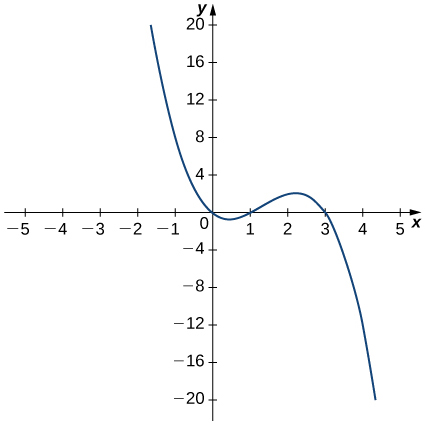
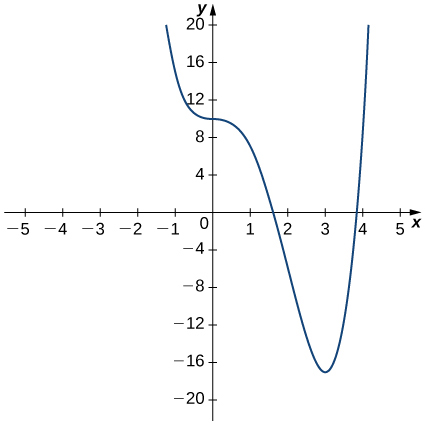
Solution

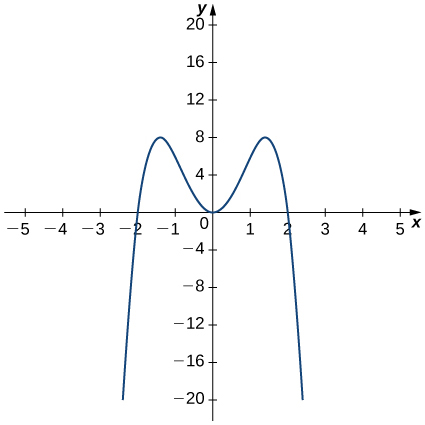
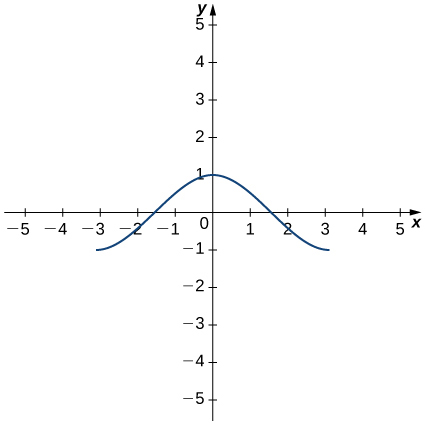
Solution

For the following exercises, the given limit represents the derivative of a function ![]() at
at ![]() . Find
. Find ![]() and
and ![]() .
.
15. ![]()
16. ![]()
Solution
![]()
17. ![]()
18. ![]()
Solution
![]()
19. ![]()
20. ![]()
Solution
![]()
For the following functions,
- sketch the graph and
- use the definition of a derivative to show that the function is not differentiable at
 .
.
21. 
22. 
Solution
a.

b. ![]()
23. 
24. 
Solution
a.

b. ![]() .
.
For the following graphs,
- determine for which values of
 the
the  exists but
exists but  is not continuous at
is not continuous at  , and
, and - determine for which values of
 the function is continuous but not differentiable at
the function is continuous but not differentiable at  .
.
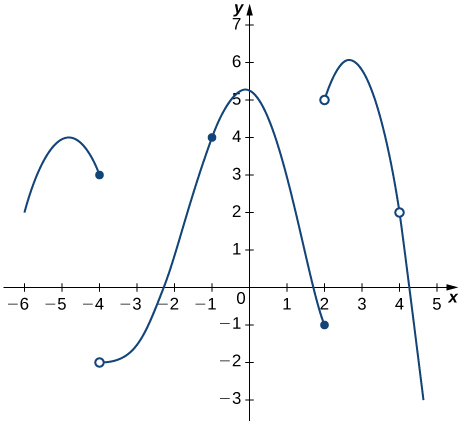
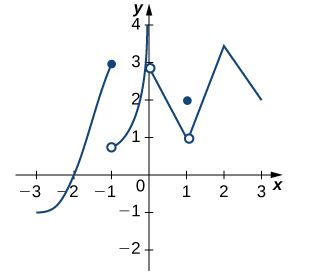
Solution
a. ![]() , b.
, b. ![]()
27. Use the graph to evaluate a. ![]() , b.
, b. ![]() , c.
, c. ![]() , d.
, d. ![]() , and e.
, and e. ![]() , if they exist.
, if they exist.

For the following functions, use ![]() to find
to find ![]() .
.
28. ![]()
Solution
0
29. ![]()
30. ![]()
Solution
![]()
For the following exercises, use a calculator to graph ![]() . Determine the function
. Determine the function ![]() , then use a calculator to graph
, then use a calculator to graph ![]() .
.
31. [T] ![]()
32. [T] ![]()
Solution
![]()

33. [T] ![]()
34. [T] ![]()
Solution
![]()

35. [T] ![]()
36. [T] ![]()
Solution
![]()

For the following exercises, describe what the two expressions represent in terms of each of the given situations. Be sure to include units.
37. ![]() denotes the population of a city at time
denotes the population of a city at time ![]() in years.
in years.
38. ![]() denotes the total amount of money (in thousands of dollars) spent on concessions by
denotes the total amount of money (in thousands of dollars) spent on concessions by ![]() customers at an amusement park.
customers at an amusement park.
Solution
a. Average rate at which customers spent on concessions in thousands per customer.
b. Rate (in thousands per customer) at which ![]() customers spent money on concessions in thousands per customer.
customers spent money on concessions in thousands per customer.
39. ![]() denotes the total cost (in thousands of dollars) of manufacturing
denotes the total cost (in thousands of dollars) of manufacturing ![]() clock radios.
clock radios.
40. ![]() denotes the grade (in percentage points) received on a test, given
denotes the grade (in percentage points) received on a test, given ![]() hours of studying.
hours of studying.
Solution
a. Average grade received on the test with an average study time between two amounts.
b. Rate (in percentage points per hour) at which the grade on the test increased or decreased for a given average study time of ![]() hours.
hours.
41. ![]() denotes the cost (in dollars) of a sociology textbook at university bookstores in the United States in
denotes the cost (in dollars) of a sociology textbook at university bookstores in the United States in ![]() years since 1990.
years since 1990.
42. ![]() denotes atmospheric pressure at an altitude of
denotes atmospheric pressure at an altitude of ![]() feet.
feet.
Solution
a. Average change of atmospheric pressure between two different altitudes.
b. Rate (torr per foot) at which atmospheric pressure is increasing or decreasing at ![]() feet.
feet.
43. Sketch the graph of a function ![]() with all of the following properties:
with all of the following properties:
-
 for
for 
-

-
 for
for 
-
 and
and 
-
 and
and 
-
 does not exist.
does not exist.
44. Suppose temperature ![]() in degrees Fahrenheit at a height
in degrees Fahrenheit at a height ![]() in feet above the ground is given by
in feet above the ground is given by ![]() .
.
- Give a physical interpretation, with units, of
 .
. - If we know that
 explain the physical meaning.
explain the physical meaning.
Solution
a. The rate (in degrees per foot) at which temperature is increasing or decreasing for a given height ![]() .
.
b. The rate of change of temperature as altitude changes at 1000 feet is -0.1 degrees per foot.
45. Suppose the total profit of a company is ![]() thousand dollars when
thousand dollars when ![]() units of an item are sold.
units of an item are sold.
- What does
 for
for  measure, and what are the units?
measure, and what are the units? - What does
 measure, and what are the units?
measure, and what are the units? - Suppose that
 . What is the approximate change in profit if the number of items sold increases from 30 to 31?
. What is the approximate change in profit if the number of items sold increases from 30 to 31?
46. The graph in the following figure models the number of people ![]() who have come down with the flu
who have come down with the flu ![]() weeks after its initial outbreak in a town with a population of 50,000 citizens.
weeks after its initial outbreak in a town with a population of 50,000 citizens.
- Describe what
 represents and how it behaves as
represents and how it behaves as  increases.
increases. - What does the derivative tell us about how this town is affected by the flu outbreak?

Solution
a. The rate at which the number of people who have come down with the flu is changing ![]() weeks after the initial outbreak.
weeks after the initial outbreak.
b. The rate is increasing sharply up to the third week, at which point it slows down and then becomes constant.
For the following exercises, use the following table, which shows the height ![]() of the Saturn V rocket for the Apollo 11 mission
of the Saturn V rocket for the Apollo 11 mission ![]() seconds after launch.
seconds after launch.
| Time (seconds) | Height (meters) |
|---|---|
| 0 | 0 |
| 1 | 2 |
| 2 | 4 |
| 3 | 13 |
| 4 | 25 |
| 5 | 32 |
47. What is the physical meaning of ![]() ? What are the units?
? What are the units?
48. [T] Construct a table of values for ![]() and graph both
and graph both ![]() and
and ![]() on the same graph. (Hint: for interior points, estimate both the left limit and right limit and average them.)
on the same graph. (Hint: for interior points, estimate both the left limit and right limit and average them.)
Solution
| Time (seconds) | |
|---|---|
| 0 | 2 |
| 1 | 2 |
| 2 | 5.5 |
| 3 | 10.5 |
| 4 | 9.5 |
| 5 | 7 |
49. [T] The best linear fit to the data is given by ![]() , where
, where ![]() is the height of the rocket (in meters) and
is the height of the rocket (in meters) and ![]() is the time elapsed since takeoff. From this equation, determine
is the time elapsed since takeoff. From this equation, determine ![]() . Graph
. Graph ![]() with the given data and, on a separate coordinate plane, graph
with the given data and, on a separate coordinate plane, graph ![]() .
.
50. [T] The best quadratic fit to the data is given by ![]() , where
, where ![]() is the height of the rocket (in meters) and
is the height of the rocket (in meters) and ![]() is the time elapsed since takeoff. From this equation, determine
is the time elapsed since takeoff. From this equation, determine ![]() . Graph
. Graph ![]() with the given data and, on a separate coordinate plane, graph
with the given data and, on a separate coordinate plane, graph ![]() .
.
Solution
![]()


51. [T] The best cubic fit to the data is given by ![]() , where
, where ![]() is the height of the rocket (in m) and
is the height of the rocket (in m) and ![]() is the time elapsed since take off. From this equation, determine
is the time elapsed since take off. From this equation, determine ![]() . Graph
. Graph ![]() with the given data and, on a separate coordinate plane, graph
with the given data and, on a separate coordinate plane, graph ![]() . Does the linear, quadratic, or cubic function fit the data best?
. Does the linear, quadratic, or cubic function fit the data best?
52. Using the best linear, quadratic, and cubic fits to the data, determine what ![]() , and
, and ![]() are. What are the physical meanings of
are. What are the physical meanings of ![]() , and
, and ![]() , and what are their units?
, and what are their units?
Solution
![]() , and
, and ![]() represent the acceleration of the rocket, with units of meters per second squared (
represent the acceleration of the rocket, with units of meters per second squared ( ![]() ).
).
Glossary
- derivative function
- gives the derivative of a function at each point in the domain of the original function for which the derivative is defined
- differentiable at

- a function for which
 exists is differentiable at
exists is differentiable at 
- differentiable on

- a function for which
 exists for each
exists for each  in the open set
in the open set  is differentiable on
is differentiable on 
- differentiable function
- a function for which
 exists is a differentiable function
exists is a differentiable function
- higher-order derivative
- a derivative of a derivative, from the second derivative to the
 th derivative, is called a higher-order derivative
th derivative, is called a higher-order derivative



Hint
Use (Figure) and follow the example.